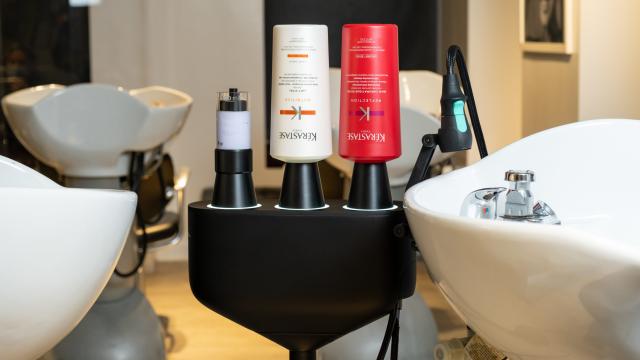While consumer electronics companies tend to dominate CES, makeup brand L’Oreal has carved out a neat little niche for itself at the show. From augmented reality makeup lines to wearable UV and pH sensors, the company always has something up its sleeve when it comes to beauty tech. This year, the L’Oreal is launching a new salon haircare system it calls Water Saver.
Basically, Water Saver is L’Oreal dipping its toes into sustainable beauty tech via a partnership with Gjosa, a Swiss environmental tech startup. As the name implies, it’s meant to help reduce water waste. There’s a connected machine that attaches to those sinks in the salon back bar where you get your hair washed. The machine itself has three slots that you then attach normal shampoos, conditioners, and treatments to. The Water Saver then creates micro-ionised water droplets by colliding them together in a highly pressurised stream to create droplets that are 10 times smaller. The system also features an accompanying dashboard that tracks what treatments were used on a particular client, as well as water and energy savings. L’Oreal claims the system uses up to 80% less water overall, or two litres per minute compared to the standard eight litres per minute.
While this isn’t the flashiest gadget, it’s nice to see something that might have a noticeable impact. Hair salons use up to 270 gallons of water per day, per chair. In general, hair salons are not-so-great for the environment due to the massive amount of plastic and chemical waste they produce — so reducing water usage by 80% would be enormous. In its press release, L’Oreal claims that if a few thousand salons were to adopt Water Saver, that could translate to up to one billion gallons saved per year.
That’s not the only benefit though. L’Oreal claims this leads to better product absorption and faster rinsing because hair care products are infused into the micro-ionized water. It creates a sort of cloud-like foam, which is quite a magical experience, if Guive Balooch, head of L’Oreal Technology Incubator, is to be believed. “This cloud cleansing effect can also help us move toward using less plastic,” Balooch said. “You could instead shift toward using powders.”
Balooch told Gizmodo that these systems are already rolling out in a couple of salons in Manhattan, with the aim of reaching several hundred salons this year and a few thousand over the next two years. “We didn’t want to tackle sustainability without having unique technology,” Balooch says, crediting L’Oreal’s previous forays into beauty tech as paving the way for the Water Saver. “We’re working with certain salons for free during the pilot to see if they love the personalisation aspect. The consumer won’t have any cost for the salon version. We’re also working on business models for salons, so they can pay for this in a short period of time based on water savings.”
That’s great on a big picture scale, but some of us rarely visit salons — especially after a year marked by lockdowns amid a pandemic. However, Balooch says L’Oreal is also working on adopting the tech for an at-home showerhead too. The consumer version is about 18-24 months away, but when it does eventually come out, Balooch says it should be priced similarly to other showerheads on the market.
In another nice update, L’Oreal also confirmed that its super cool, personalised makeup-dispensing gadget Perso is not vaporware. We got to check out Perso at CES 2020 and it was an impressive blend of gadgetry, AR, and AI — but the kind of tech that sometimes never makes it off the CES showroom floor. L’Oreal is partnering with Yves Saint Laurent to launch the Yves Saint Laurent Rouge Sur Mesure Powered by Perso. (Say that three times fast.)
Instead of skincare, this version of the device uses colour cartridges to dispense thousands of custom lipstick shades. It’s a bit pricey at $US300 ($387) for the device and $US100 ($129) for three cartridges — but Balooch notes that you can get over 5,000 shades and that YSL lipsticks generally go for $US30 ($39)-$US37 ($48) each. Preorders start today, and the devices are expected to ship in spring.
Editor’s Note: Stay tuned for local Australian pricing and availability.
